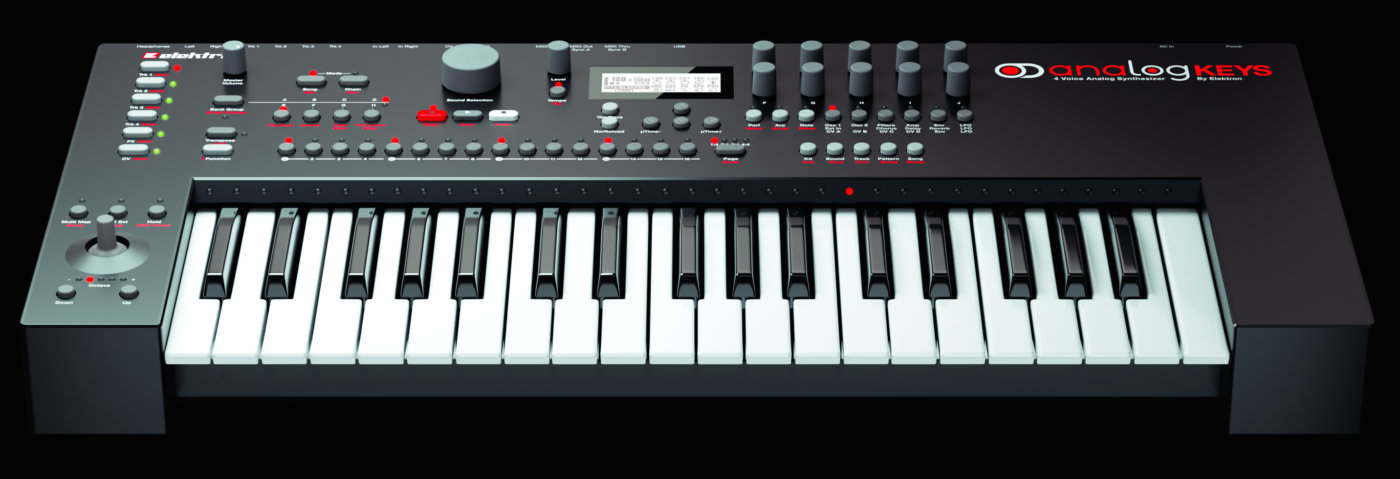Hands-on control
In terms of real-time performance, the most obvious upgrades from the Analog Four are the keyboard itself and the additional controls which go with it. The keybed is a very high quality 37-key velocity-sensitive setup with aftertouch. The Analog Keys also includes two notable features adopted from the discontinued Monomachine SFX-6.
The first is the row of red LEDs above the keyboard, one per key, which light up to indicate when each note’s being played, either directly by the keyboard, over MIDI, using the arpeggiator or, most importantly, when playing back sequences. It’s a relatively small feature, perhaps, but surprisingly useful in the absence of a screen to display sequencer note information.
It’s a relatively small feature, but surprisingly useful
The second feature taken from the Monomachine is the 360-degree joystick, positioned where you’d typically find pitch bend and modulation controls. A joystick on a synth is certainly nothing new (even before the Monomachine, you can take your pick from the EMS synths of the 60s and 70s, the Sequential Circuits Prophet VS in the 80s or the Korg Wavestation in the 90s), but the Elektron implementation is the most versatile I’ve come across. Up to 15 parameters can be controlled simultaneously, which offers a hell of a lot more hands-on control than the usual pitch and mod options.
The one disappointing feature of the control setup can be summed up by the large expanse of empty space on the right-hand side of the Analog Keys front panel. With so many parameters to control and so
much potential for real-time manipulation, that blank space seems like a wasted opportunity. A couple of assignable knobs would be very welcome here. Even something as simple as dedicated filter cutoff and resonance controls – perhaps large, widely-spaced knobs for ease of use – would be an advantage.
Instead, the focus is on the main bank of twelve rotary encoders clustered to the right-hand side of the screen, which change function as you select the different parameter pages (oscillators, filters, amp, envelopes and so on – a total of 17 pages) and Performance, Arp, Note and Setup options. If I was being picky I might say that the rotaries are a little too tightly packed for my oversized fingers, but there’s still just about enough space to get in and adjust the synth’s huge range of parameters. With so many options to choose from you’d better be ready to get familiar with those rotary pots.
Overbridge
The complexity of the editing system is the weakest point of an otherwise incredibly impressive synth, but that’s set to change by the end of this year. Last week, Elektron announced Overbridge, a new software protocol which promises to provide exactly the kind of seamless software integration the Analog Keys is crying out for. With Overbridge, synth parameters will be edited via a VST/AU plugin, audio can be streamed over USB in both directions (for recording into a DAW or processing audio signals using the keyboard’s filters) and patches can be stored and recalled. (Overbridge will also work with the Analog Four and Analog Rytm.)
Sadly, as powerful as Overbridge sounds, I can’t bump up the score of the Analog Keys on the basis of software which won’t be released for at least another six months. If you’re reading this in the final quarter of 2014, Overbridge should be available. Otherwise, the Analog Keys is a seriously flexible synth with an editing system that doesn’t necessarily make it easy to access its full potential.
Overbridge certainly looks like a step in the right direction
This is a hardware synth with a feature set as thorough and complete as you’d normally expect in a plugin. As such, it’s a long, long way from one-knob-per-function editing, and there’s no doubt that a software editor would make it a little easier to tame. Overbridge certainly looks like a step in the right direction, but we’ll reserve judgement until it’s readily available.
Conclusion
At £1,449, the Analog Keys is priced well into premium synth territory. Price expectations might have been lowered recently by affordable monosynths such as the MiniBrute and MS-20 Mini, but it’s important to bear in mind that the Analog Keys is polyphonic and significantly better made than the vast majority of keyboards.
As such, the closest rival is probably the DSI Mopho x4, which is significantly cheaper but doesn’t offer any sequencing options or multitimbral capabilities. Given that the Analog Four is priced at £1,099, the extra £250 seems more than reasonable for a very good keyboard, versatile joystick and a handful of small but significant improvements over the module.
The Analog Keys is a serious synth. Like all Elektron offerings, it’s a little idiosyncratic, but it’s also incredibly rewarding once you learn your way around its editing system and unlock the deeper synthesis and sequencing capabilities. It’s a valuable addition to the Elektron product range and a true flagship model. The forthcoming software editor will undoubtedly simplify the editing process, but even as it stands the Analog Keys is a thoroughly impressive synth.
The Verdict
Price: £1,449
Purchase: Elektron Analog Keys
The Final Word
A true flagship polysynth which reflects Elektron's ethos. Idiosyncratic and fiddly, but versatile and stunningly powerful

10.05 AM
Interesting Read .. any sound examples?
10.14 AM
Hi Angie. We don’t create audio demos for all of our reviews but in addition to the Elektron demos above there are some really excellent user demos of the Analog Keys and Analog Four (which sounds virtually identical) on YouTube and SoundCloud.
02.53 PM
I’ll say that after having my A4 for about a year now, a keyboard would be a great companion, the tiny keys on the original don’t exactly lend themselves well to spontaneous performance.
12.48 PM
Some Sound examples and free patches for your A4 or AK https://soundcloud.com/synthausen/sets/free-analog-four-patches